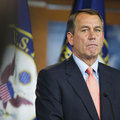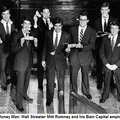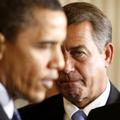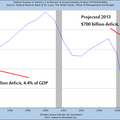 Some tracking polls with two days of debate in their survey data show Obama gaining, but it's still pretty early to say much more than that as far as what it means.
Some tracking polls with two days of debate in their survey data show Obama gaining, but it's still pretty early to say much more than that as far as what it means.
- RAND has a static, non-random group of about 3,500 voters that it polls once per day in groups of 500 or so, such that a given group is only polled once per week. Their experimental poll has Obama up by 3.8 points yesterday, and 4.1 points today.
- Rasmussen has Romney down a point from yesterday, to +3.
- PPP, like RAND, has Obama gaining day-to-day, up by 1 point today, from a tie yesterday, and Romney +2 on Tuesday.
- Ipsos/Reuters moved three points towards Mitt Romney today, R+2 after showing O+1 yesterday, and tie the two days before that.
- Gallup has Romney at +3 today and yesterday, after having him up by 5 points on Tuesday, 6 points on Monday, and 7 points on Sunday. Most of that fall does not include the final debate.
- IBD/TIPP has Obama down a point from yesterday (+3), up by 2.
- UPI/CVOTER has Obama up by 2 today and yesterday, better than the tie on Tuesday.
- Because we don't have enough trackers already, ABC/Washington Post debuted their tracker today, showing Romney up by 1 point.
* * *
Obama leads the tracker average today by 0.13 points, and the median of the same is tied.
The only non-tracking national poll I could find today was AP-GfK, showing Mitt Romney up by 2 points. Obama leads the non-tracker average of the last 10 national polls by 0.3 points, and the median of the same by 0.5 points.
* * *
The electoral college projections remain stable, the only two notable things are that Real Clear Politics' tossup up has dropped Mitt Romney by 7 electoral votes, returning Barack Obama to a silly 201-191 lead. The RCP map without tossups remained 281-257 in favor of Obama. All projections except that weird UoC model now project Barack Obama to win the 2012 election, just as they did on October 16th.
The other notable thing is that I've added a median calculation to the average for all projections. A median will smooth out outlier, like Electoral-Vote.com and Josh Putnam, which give Obama 332 electoral votes, and RCP only giving him between 201-206.
The last five averages consisting of 13 projections look like this:
10/16: Obama 264, Romney 208
10/19: Obama 272, Romney 216
10/21: Obama 268, Romney 210
10/23: Obama 268, Romney 216
10/25: Obama 260, Romney 212
And the last five medians:
10/16: Obama 271, Romney 206
10/19: Obama 277, Romney 206
10/21: Obama 274, Romney 199
10/23: Obama 276, Romney 206
10/25: Obama 277, Romney 206
There's one big caveat, being that not all of these sites push tossups. 538/Nate Silver never has tossups, while some, like RCP, have too many tossups to be taken seriously. Thus movement in the 538 projection is an absolute movement in the race, whereas movement in RCP, Pollster, etc, are not.
It would take some time to go through all those projections and manually push them to an absolute result, so I won't be doing that today. But I will do that very soon. You can already see what the result will be by looking at the median, though. The 10/23 median accounts for 483 of 538 electoral votes and already projects Barack Obama to win enough states for the remaining tossups not to matter. In fact, every single median calculation would result in the same end game: Obama wins. Just by different margins.
The averages aren't that far from it. While Obama can't lose any of the median projections (assuming they are correct), he can technically lose all but one of the averages. However, you've got to take the odds of that happening into account. Even in Romney's best projection of the averages, Obama is still just 10 electoral votes from winning, and Romney needs 58. In that scenario, there are only 66 electoral votes left.
So while the national polls and even trackers look tied, Mitt Romney is still losing, and losing soundly. The last time I looked at state polling and used Romney's most favorable map, RCP with tossups where he was ahead 206-201, Romney still lost by the exact same margin that RCP's no tossups map projected, 257-281.
While that may look close, you have to understand that entire states have to move from one column to the other for that number to change by even a single point. It's trivial for a national poll to move five points in either direction due almost entirely to noise and error. To move multiple states from one candidate leading to the other would require a measurable and demonstrable change in sentiment of an entire state's population.
To give you an example, Ohio looks close when you look only at each recent poll separate from all the others. Of the last 10 polls, Obama has lead 6 and tied in the other 4. Together, they show Obama with a ~2.3 point lead on average across say 10-13 of the most recent polls.
Ohio is worth 18 electoral votes and in the 281-257 Obama win scenario, Obama wins Ohio and thus the election. For Romney to win Ohio, shifting the electoral projection to 263-275 in his favor, Romney would have to show an average lead in Ohio, which he hasn't been able to do all year. His last polling lead came on October 15th and Obama had lead 6 of the previous 7 polls before that.
Now consider that the electoral college is probably not quite that tight. Nate Silver has it at 291-247 this afternoon, and even winning Ohio wouldn't do it for Romney. He'd probably need Ohio and then one more state with at least 5 electoral votes to hit 270. So if Mitt Romney hasn't lead a poll in Ohio of the last 10-13, and he needs at least Ohio and one more state just to break 270, what are the chances he's going to win the election, even as national polls and trackers are tied? Probably worse than the 29% that Romney is showing from 538 today.
* * *
One last thing to note about Nate's data. We know that Obama was a favorite to win even before the GOP primary, and a favorite to win after. He was a big favorite after the conventions, and a narrow favorite after the first debate. But what does that translate to in numbers? Where is Obama and Romney now, compared to say, each candidates high and low points?
I find this informative:
Aug 23
Obama: 68.4%
Romney: 31.4%
Aug 26: Republican National Convention
Sept 4: Democratic National Convention
Sept 8
Obama: 79.8%
Romney: 20.2%
Sept 16
Obama: 74.8%
Romney: 25.2%
Oct 3: Presidential Debate #1 in Denver
Oct 4
Obama: 87.1%
Romney: 12.9%
Oct 11: Presidential Debate #2 in Hempstead
Oct 12
Obama: 61.1%
Romney: 38.9%
Oct 22: Presidential Debate #3 in Boca Raton
Oct 23
Obama: 68.1%
Romney: 31.9%
Today/Oct 25
Obama 71%
Romney 29%
If one only considers very recent history, then Obama is still down quite a bit form his post-convention high. But Romney is also down from his post-debate high. Compared to the state of the race before those two paradigm shifts, Obama is actually up a little and Romney down a bit. If the DNC significantly increased Obama's chances of winning the election, and the debate Romney's, then Obama hasn't gotten everything back that he once had, but he's gotten everything back and then a little that he had before all of that happened.
Aug 23: Obama 68.4, Romney 31.4
Today: Obama 71, Romney 29
In other words, Obama hasn't gotten back his post-convention high, but his post-convention high was so high that he's in a better position now to win the election that he was in August, even after taking a debate beating. For Mitt Romney to truly have a shot at winning this election, he really needed to not have such a mediocre convention. Had the convention fortunes been reversed, I think Romney would be the favorite to win today.
But that's not what happened.
If each side's supporters want something to hang their hat on, there's something there for everyone.
Mitt Romney took a real beating at the conventions and had virtually no chance of winning immediately after them. He's since clawed back into a respectable position from which he can still win the election.
Barack Obama took a real beating at the first debate but has clawed back enough lost support to still be in a better position to win the election today than he was in before either the conventions or the debates.
I don't expect much to change between now and election day that will rewrite that narrative.










